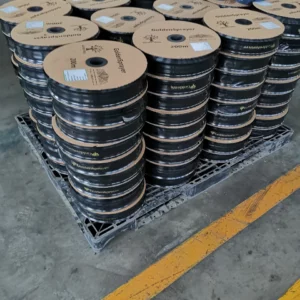How do you determine the optimal spacing and flow rate for drip emitters in a drip irrigation system?
Determining the optimal spacing and flow rate for drip emitters in a drip irrigation system depends on several factors, including the type of plants, soil characteristics, water requirements, and system design.
Here’s a general approach to determining these parameters:
Water Requirements: Start by assessing the water requirements of the plants or crops you intend to irrigate. Consider factors such as plant type, growth stage, climate, and soil moisture retention capacity. This information can be obtained from agricultural extension services, plant nurseries, or irrigation guidelines specific to your region or crop.
Soil Characteristics: Evaluate the soil type and its ability to hold and distribute water. Factors such as soil texture, infiltration rate, and water-holding capacity influence the spacing and flow rate of drip emitters. Soils with high clay content retain water better than sandy soils and may require different emitter spacing and flow rates.
Emitter Flow Rate: Determine the flow rate of each drip emitter based on the water requirements of the plants and the desired irrigation duration. Flow rates are typically measured in gallons per hour (GPH) or liters per hour (LPH). Consider the plant’s water needs, root depth, and local environmental conditions when selecting the appropriate flow rate. Manufacturer specifications often provide guidance on emitter flow rates based on plant types and spacing.
Spacing Considerations: The spacing between drip emitters depends on the plant’s root spread, the soil’s water-holding capacity, and the desired wetting pattern. In general, spacing can range from a few inches to several feet, depending on the plant’s size and water requirements. Smaller plants may require closer spacing, while larger plants may have wider spacing. Additionally, consider the lateral distance between the emitters to ensure uniform coverage without excessive overlap or gaps.
Uniformity and Distribution: Aim for uniform water distribution across the irrigated area. Avoid overwatering or underwatering certain sections. Adjust the spacing and flow rate to achieve even water distribution throughout the root zone. Regularly monitor the system’s performance and make adjustments as necessary to ensure consistent watering.
System Design: Consider the layout and design of the irrigation system, including the type of tubing, pressure regulators, filters, and valves used. These components can impact the overall performance and influence the spacing and flow rate decisions. Ensure that the system design supports the desired emitter spacing and flow rates.
It’s important to note that specific crops, local regulations, and environmental conditions may have additional guidelines or recommendations for drip emitter spacing and flow rates. Consulting with local agricultural experts, irrigation professionals, or referring to industry standards and guidelines can provide valuable insights tailored to your specific needs and conditions.
How does a drip irrigation system conserve water and promote water efficiency?
A drip irrigation system conserves water and promotes water efficiency in several ways:
Precise Water Delivery: Drip irrigation systems deliver water directly to the plant’s root zone, minimizing water loss due to evaporation or runoff. Unlike conventional irrigation methods such as sprinklers, which spray water over a wide area, drip emitters release water slowly and close to the plant’s base. This targeted approach ensures that water reaches the plants efficiently without being wasted on non-growing areas or weed growth.
Reduced Evaporation: By delivering water at the soil level, drip irrigation minimizes water exposure to the air, reducing evaporation losses. This is especially beneficial in hot and arid climates where evaporation rates are high. The water drips directly to the soil surface, allowing it to penetrate deeply and be absorbed by the plant’s roots before significant evaporation can occur.
Elimination of Overspray and Wind Drift: Drip irrigation systems eliminate overspray and wind drift associated with sprinkler systems. drip irrigation system With sprinklers, water can be carried away by wind or fall on non-targeted areas such as walkways, driveways, or neighboring properties. Drip emitters release water precisely where it is needed, minimizing wastage and ensuring efficient water use.
Reduced Weed Growth: Drip irrigation delivers water directly to the plant’s root zone, minimizing moisture availability in non-growing areas. This helps reduce weed growth since weeds typically thrive in areas with abundant surface moisture. By minimizing weed growth, water is conserved and directed solely towards the intended plants.
Customization and Control: Drip irrigation systems offer flexibility in water application. Flow rates and timing can be adjusted based on specific plant needs, growth stages, and environmental conditions. This level of customization allows for optimal water usage, ensuring that plants receive the right amount of water at the right time. Watering can be scheduled during early morning or evening hours when evaporation rates are lower, further enhancing water efficiency.
Reduced Nutrient Leaching: Drip irrigation systems also help minimize nutrient leaching. By delivering water directly to the root zone, nutrients applied to the soil (such as fertilizers) are less likely to be washed away by excess water. This promotes efficient nutrient uptake by the plants and reduces the risk of nutrient runoff into water bodies.
Water Recycling and Reuse: Drip irrigation systems can be designed to facilitate water recycling and reuse. By using filters and water treatment systems, the water that drains from the system can be captured, filtered, and reused for irrigation purposes. This reduces the dependence on fresh water sources, conserves water resources, and promotes sustainable irrigation practices.
Overall, drip irrigation systems provide precise and efficient water delivery, minimizing water waste and maximizing plant health. By conserving water, these systems contribute to sustainable agriculture practices, reduce water bills, and help address water scarcity challenges in many regions.
